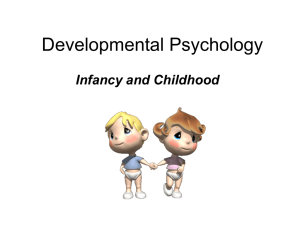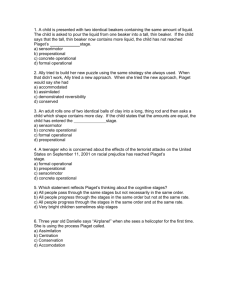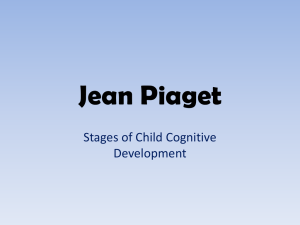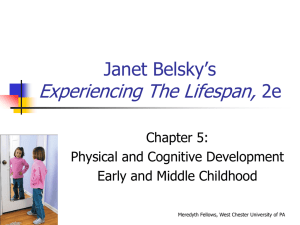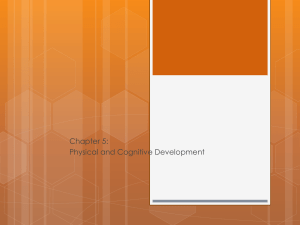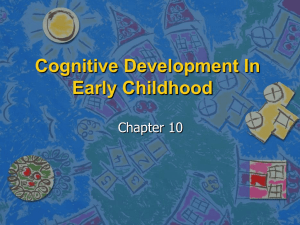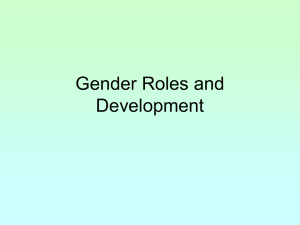Chapter 5
advertisement
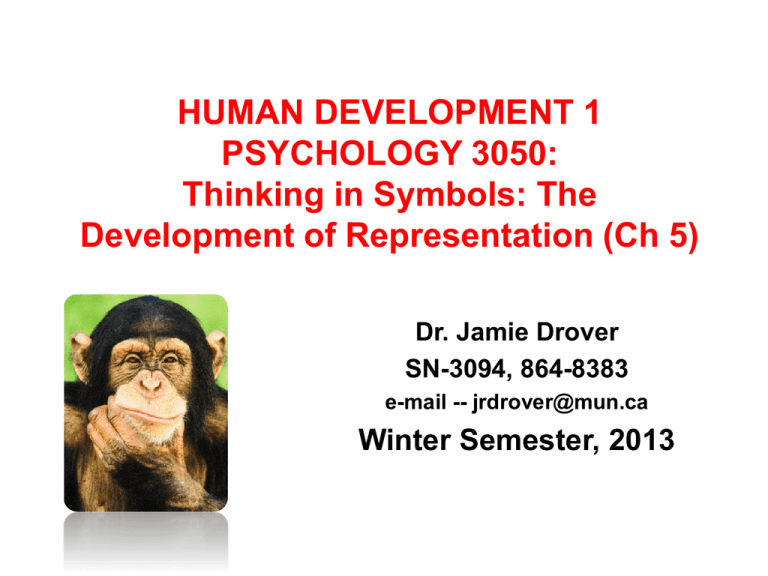
HUMAN DEVELOPMENT 1 PSYCHOLOGY 3050: Thinking in Symbols: The Development of Representation (Ch 5) Dr. Jamie Drover SN-3094, 864-8383 e-mail -- jrdrover@mun.ca Winter Semester, 2013 Learning to Use Symbols • Symbols: external referents for objects and events. • Representational Insight: Knowledge that an entity can stand for something other than itself. Young Children’s Interpretation of Pictures and Models • DeLoache (1987) had 2- and 3-year-old children search for a toy hidden in a room. • Earlier, they are shown a model room that illustrates where the toy is. • They then have to find the toy in the room. • Then have to find the model toy in the model room. Young Children’s Interpretation of Pictures and Models 3-year-olds possess representational insight. 2.5-year-olds do not Young Children’s Interpretation of Pictures and Models • If a picture is used instead of a scale model, 2.5year-olds show representational insight, whereas 2-year-olds do not (DeLoache 1987). • These findings may reflect difficulty with dualrepresentation. • A model is its own item, worthy of its own attention. • When models are made less interesting, performance changes. Young Children’s Interpretation of Pictures and Models • When models were viewed through a window, 2.5 year-olds’ performance was better than on the model task. • When 3-year-olds were allowed to play with the model beforehand, performance decreased. • DeLoache et al. (1997) designed a task that did not require dual representation. Young Children’s Interpretation of Pictures and Models • “credible shrinking room studies” -- 2.5 yr olds can succeed – “shrinking machine” can shrink room – shown “Terry the Troll” – machine “shrinks” (then enlarges) Terry Young Children’s Interpretation of Pictures and Models Young Children’s Interpretation of Pictures and Models • Standard model task – hide Terry in large room – Room was “shrunk” – 2.5 yr can find Terry in small room • No need for representational link between model and the room, instead -- large and small room believed to be the same thing – no dual representation needed Young Children’s Interpretation of Pictures and Models • Even an 18 month-old will show basic symbolic play. • But this is not necessarily dual representation. • DeLoache et al. (1998) presented pictures to 9 to 19 month-old children from the US and the Ivory Coast. • The youngest children treated them as objects. Young Children’s Interpretation of Pictures and Models • By 19 months of age, they realized the picture represented something else. The Appearance/Reality Distinction • The knowledge that the appearance of an object does not necessarily correspond to its reality. The Appearance/Reality Distinction • De Vries (1969) studied qualitative identity – Children were familiarized with a trained cat. – The cat was then fitted with a dog mask. – 3-year-olds believed the mask changed the identity of the cat. • Flavell (1986) poured white milk into a red glass while young children were watching. • Showed children a sponge that looked like a rock. The Appearance/Reality Distinction • They were asked what does it look like to your eyes right now? • Asked, what is it, really and truly? • Made two kinds of errors. • Phenomenism errors: said milk was really and truly red. • Intellectual realism: Said the fake rock looked like a sponge. The Appearance/Reality Distinction • Young children’s poor performance on appearance/reality distinction tasks is surprisingly pervasive. • Might stem from problems with dual encoding. • They have trouble representing an object in more than one form at a time. Jean Piaget • A Swiss philosopher/psychologist first trained as a biologist. • Has had the greatest impact on developmental psychology. • Emphasized the role of children in development. • Children are not incomplete adults. – Think differently, qualitative differences. Assumptions of Piaget’s Theory • We develop in discrete stages. • Cognitive development is through a series of transformations. – But underlying functions are continuous. • Mechanisms of cognitive development are domain-general (homogeneity of function). 17 Assumptions of Piaget’s Theory • Children are not passive creatures, they are intrinsically active and possess an innate curiosity and seek stimulation. – The motivation for development is within the child. – They are primarily responsible for their own development. Assumptions of Piaget’s Theory • Cognition is a constructive process. • We interpret the world through our own personal perspective, ie, through what we already know. – Constructivism • Children at different levels construct different realities. The Constructive Nature of Cognition • They come to know objects by acting on them – action schemes. • Scheme: the basic unit of knowledge. • These action schemes become internalized – operations or operational schemes. 20 Functional Invariants • Processes that characterize all biological systems (including intelligence) and operate throughout the lifespan. • Organization: Through organization, every intellectual operation is related to all other acts of intelligence. – Structures/schemes are not independent, but are coordinated. – Domain general 21 Functional Invariants • Adaptation: the organism’s ability to adjust its structures to environmental demands. • Assimilation: the incorporation of new information in already existing schemes. • Accommodation: a current scheme is changed to incorporate new information. 22 Assimilation and Accommodation • Knowledge is constructed by these processes. • Every act of intelligence involves both. – One may predominate over the other. – Play, imitation 23 Equilibration • The organism’s attempt to keep its cognitive structures in balance. • When information does not match current schemes, disequilibrium results. • Achieved through alteration of cognitive structures (e.g., accommodation). • The child may also assimilate. 24 Stages of Development • The order of the stages are invariant and culturally universal. • Development is epigenetic – Based on bidirectional interactions between structure and function. – Later development is based on earlier development. – New structure is a transformation of an earlier one. 25 The Sensorimotor Stage • Birth to 2 years. • Intelligence is limited to one’s own actions on the environment. • Do not form mental representations. – Understand only what is physically present. • Knowledge progresses from sensorimotor to representational thinking. 26 The Sensorimotor Stage • There is a change in personal perspective. – Learn to differentiate themselves from the external world. • • • • There are six substages 1) the use of reflexes: Birth to 1 month Use reflexes to interpret the world They apply reflexes to objects and assimilate them to their schemes. 27 The Sensorimotor Stage • • • • Highly restricted in what they can know. They do not behave intentionally, but can adapt. 2) Primary circular reactions: 1 to 4 months Reflexes are extended, new patterns of behavior are acquired. • Can modify reflex schemes. 28 The Sensorimotor Stage • Primary Circular Reactions: the first class of acquired repetitive behaviors. • Based on hereditary reflexes • Show primitive signs of intentionality. 29 The Sensorimotor Stage • 3) Secondary Circular Reactions: 4 to 8 months. • Not based on reflexes, but represent the first acquired new behaviors. • These behaviors first appear by chance. • 4) Coordination of secondary circular reactions: 8 to 12 months. • Show goal-directed behavior and cause and effect. 30 The Sensorimotor Stage • Coordinates secondary circular reactions. • 5) Tertiary Circular Reactions: 12 to 18 months. • Characterized by clear means/end differentiation. • Can alter existing schemes directly related to obtaining a solution. • Show increasing locomotive abilities. • Show a peak in curiosity. 31 The Sensorimotor Stage • Still cannot form mental representations. • Solve problems through trial and error. • 6) Invention of new means through mental combinations. • Symbolic functioning is first seen. • New means are invented through mental combinations. 32 The Sensorimotor Stage • Show symbolic function through language, deferred imitation, gestures, and mental imagery. 33 The Development of Operations • In the three stages following the sensorimotor stage, children can form mental representations. • Preoperations: 2-7 • Concrete Operations: 7-11 • Formal Operations: Begins at 11 34 The Development of Operations • Operations: Cognitive schemes that describe ways in which children act on their world. • Mental; require the use of symbols • Derive from action. They are internalized actions. • Exist within an organized system. – All cognitive operations are integrated. 35 The Development of Operations • Operations are logical and follow rules. • Reversibility – knowledge that an operation can be reversed. Two types: – negation – an operation can be negated, or inverted • (5+2 = 7; 7-2 = 5) – compensation -- change in one dimension offset by changes in another -- a tall thin man and a short fat man can weigh the same 36 The Transition from Preoperational to Concrete Operational Thought • Thinking in the preoperations stage is intuitive, lacking logic. • More concerned with appearance than logic Conservation • The realization that an entity stays the same despite changes in its form. • This is the sign that one has achieved concrete operations. 37 The Transition from Preoperational to Concrete Operational Thought • E.g. conservation of liquid (volume). • 5-year-olds cannot solve this problem. 8-yearolds can solve the problem and explain why. 38 The Transition from Preoperational to Concrete Operational Thought • The pre-operational child thinks intuitively. • If the liquid is poured back into the original container, preoperational children claim the amounts are equal. • This does not produce contradiction (disequilibrium) in the preoperational child. – But it does in older children. They will soon accommodate. 39 The Transition from Preoperational to Concrete Operational Thought • Conservation does not develop simultaneously for all properties of materials. • Number before mass before weight before volume – Note that there is heterogeneity here. Conservation of Number 40 The Transition from Preoperational to Concrete Operational Thought Reversibility • Preoperational children can not apply negation or compensation to conservation problems. Centration v. Decentration • Preoperational children’s perception is centered. • They make judgments based on the most salient aspect 41 The Transition from Preoperational to Concrete Operational Thought • Concrete operational children are decentered. • Can remove their attention from specific aspects of the conservation problem and make decision based on all dimensions. • Centration is not limited to conservation tasks but is found in everyday life – Use height to estimate age 42 The Transition from Preoperational to Concrete Operational Thought Egocentricity • Preoperational children assume that others see the world as they do. • This permeates their complete cognitive world. • Perhaps this egocentricity is adaptive. 43 Transition from Concrete to Formal Operational Thought • In early adolescence, children’s thoughts are no longer applied to the concrete. – Not limited to tangible facts or object Hypothetico-Deductive Reasoning • The benchmark of formal operations. • They can generate hypotheses. • Can think solely on the basis of symbols. 44 Transition from Concrete to Formal Operational Thought • Can generate ideas not yet experienced. Thinking like a scientist • Can think inductively. • Go from specific observations to broad generalizations. • Hypotheses are generated then systematically tested. 45 Transition from Concrete to Formal Operational Thought • Pendulum problem • Given four factors that can affect pendulum speed – String length, weight of object, height of release, force of push. • Must formulate a hypothesis • Vary a single factor while holding the others constant. 46 Transition from Concrete to Formal Operational Thought • Preoperational children can carry out the first step. • Concrete operational children can’t get the right answer. – Can’t isolate a variable. • Thinking About Thinking • Can examine the content of their own thought. 47 Transition from Concrete to Formal Operational Thought • Can acquire new information from internal reflection. • Reflective abstraction: a rearrangement, by means of thought, of some matter previously presented to the subject in a rough or immediate form. Egocentricity • Adolescents demonstrate centration. 48 Transition from Concrete to Formal Operational Thought • Believe that their abstract ideas are unique to them. • Adolescents are extremely self-conscious. • Playing to an imaginary audience. • Leads to the personal fable – Belief in uniqueness and invulnerability. – May explain reckless behavior • May be adaptive by ensuring experimentation and independence. 49 Transition from Concrete to Formal Operational Thought • It’s debatable whether adolescents or even adults are the logical thinkers Piaget thought they were. • Formal operational thought is used by adults in some contexts, but not in other. 50 The State of Piaget’s Theory Today • Piaget’s theory continues to influence us today. • But is it accurate? • Contributions • Founded cognitive development as we know it. – Became task focused • Emphasized the active role of the child. – Constructivism 51 The State of Piaget’s Theory Today • Equilibration as an explanation. • Introduced critical concepts. – Scheme, object permanence, egocentrism • Provided an accurate description of development. • Influence went beyond cognitive development. 52 The State of Piaget’s Theory Today • Piaget’s intent was to measure competence. • May have underestimated the competence of children. – Object permanence, mental representation, egocentricity • Children can be trained to think at a higher level. – Conservation – May be context specific 53 The State of Piaget’s Theory Today • In some cases, Piaget may have overestimated how adults think. – See garlic powder example (p 182; Capon & Kuhn, 1977). 54 Fuzzy Trace Theory • Piaget’s theory is not perfect. • New forms of thinking don’t necessarily replace older ones. • Older children and adults can solve problems illogically. • Dual-Processing: There are multiple ways of knowing, or of solving problems. Fuzzy Trace Theory • Based on intuitionism: People think, reason, and remember by processing inexact “fuzzy” memory representations. • Cognition is intuitive. • Memory traces exist on a literal/verbatim – fuzzy/gistlike continuum. • People of all ages prefer to use fuzzy traces when solving problems. – The extent of this preference changes with age. • Reduction to essence rule Fuzzy Trace Theory • Fuzzy traces are more easily accessed than verbatim traces. • Verbatim traces are more susceptible to interference. • Making responses produces output interference that hinders performance. – Scheduling effects: caused by serial nature – Feedback effects Developmental Differences • There are changes in gist extraction. • Young children are biased toward storing and retrieving verbatim traces. • A verbatim to gist shift occurs during the elementary school years. • Brainerd and Gordon (1994) have provided evidence for this (p. 191). – Preschool children showed better memories for verbatim questions than for other questions. Developmental Differences • Age differences have been found in sensitivity to output interference. • Verbatim memory traces are more sensitive to interference than fuzzy traces.

